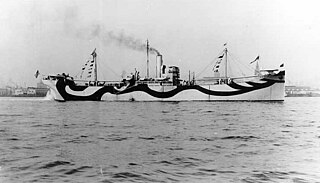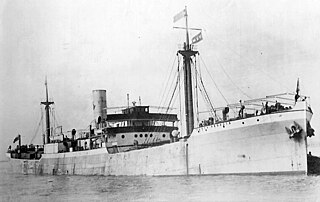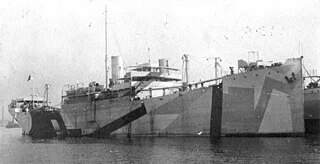Operational history
Assigned to the Naval Overseas Transportation Service to operate on a United States Army account, Berwyn moved from Sparrows Point to Baltimore, Maryland, and loaded a cargo of ordnance bound for France. Underway late on 19 October 1918, Berwyn stood down the Chesapeake Bay and dropped anchor off Old Point Comfort, Virginia on the morning of 20 October 1918. At 18:30 hours on 20 October 1918, almost seven hours after the ship had taken on board ammunition, Berwyn's crew discovered a fire in the number three hold. The blaze stubbornly resisted efforts to put it out, but the firefighters contained it and finally extinguished it early on 21 October 1918.

The United States Army (USA) is the land warfare service branch of the United States Armed Forces. It is one of the seven uniformed services of the United States, and is designated as the Army of the United States in the United States Constitution. As the oldest and most senior branch of the U.S. military in order of precedence, the modern U.S. Army has its roots in the Continental Army, which was formed to fight the American Revolutionary War (1775–1783)—before the United States of America was established as a country. After the Revolutionary War, the Congress of the Confederation created the United States Army on 3 June 1784 to replace the disbanded Continental Army. The United States Army considers itself descended from the Continental Army, and dates its institutional inception from the origin of that armed force in 1775.

Artillery is a class of heavy military ranged weapons built to launch munitions far beyond the range and power of infantry's small arms. Early artillery development focused on the ability to breach defensive walls and fortifications during sieges, and led to heavy, fairly immobile siege engines. As technology improved, lighter, more mobile field artillery cannons developed for battlefield use. This development continues today; modern self-propelled artillery vehicles are highly mobile weapons of great versatility providing the large share of an army's total firepower.

France, officially the French Republic, is a country whose territory consists of metropolitan France in Western Europe and several overseas regions and territories. The metropolitan area of France extends from the Mediterranean Sea to the English Channel and the North Sea, and from the Rhine to the Atlantic Ocean. It is bordered by Belgium, Luxembourg and Germany to the northeast, Switzerland and Italy to the east, and Andorra and Spain to the south. The overseas territories include French Guiana in South America and several islands in the Atlantic, Pacific and Indian oceans. The country's 18 integral regions span a combined area of 643,801 square kilometres (248,573 sq mi) and a total population of 67.3 million. France, a sovereign state, is a unitary semi-presidential republic with its capital in Paris, the country's largest city and main cultural and commercial centre. Other major urban areas include Lyon, Marseille, Toulouse, Bordeaux, Lille and Nice.
Resuming her voyage on 29 October 1918, Berwyn steamed for New York City, anchoring off the Statue of Liberty at 01:00 hours on 31 October 1918. Underway again on 1 November 1918 bound for France, Berwyn encountered much heavy weather along the way, shipping heavy seas over the after part of the ship that resulted in some of the deck cargo being jostled adrift by the action of the waves. Making landfall at the Île d'Yeu in France on 16 November 1918 - five days after Armistice with Germany had ended World War I - Berwyn proceeded to Quiberon Bay, where she anchored that afternoon. Ordered to Nantes, France, on the morning of 17 November 1918, she reached that port late on 18 November 1918.

The City of New York, usually called either New York City (NYC) or simply New York (NY), is the most populous city in the United States. With an estimated 2018 population of 8,398,748 distributed over a land area of about 302.6 square miles (784 km2), New York is also the most densely populated major city in the United States. Located at the southern tip of the state of New York, the city is the center of the New York metropolitan area, the largest metropolitan area in the world by urban landmass and one of the world's most populous megacities, with an estimated 19,979,477 people in its 2018 Metropolitan Statistical Area and 22,679,948 residents in its Combined Statistical Area. A global power city, New York City has been described as the cultural, financial, and media capital of the world, and exerts a significant impact upon commerce, entertainment, research, technology, education, politics, tourism, art, fashion, and sports. The city's fast pace has inspired the term New York minute. Home to the headquarters of the United Nations, New York is an important center for international diplomacy.

The Statue of Liberty is a colossal neoclassical sculpture on Liberty Island in New York Harbor in New York, in the United States. The copper statue, a gift from the people of France to the people of the United States, was designed by French sculptor Frédéric Auguste Bartholdi and its metal framework was built by Gustave Eiffel. The statue was dedicated on October 28, 1886.
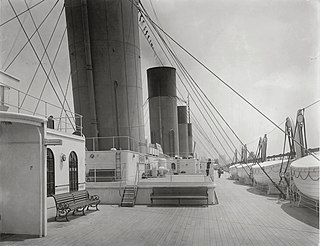
A deck is a permanent covering over a compartment or a hull of a ship. On a boat or ship, the primary or upper deck is the horizontal structure that forms the "roof" of the hull, strengthening it and serving as the primary working surface. Vessels often have more than one level both within the hull and in the superstructure above the primary deck, similar to the floors of a multi-storey building, that are also referred to as decks, as are certain compartments and decks built over specific areas of the superstructure. Decks for some purposes have specific names.
After discharging her cargo at Nantes, Berwyn took on board a return cargo that included airplanes and ammunition. Underway again on the morning of 2 December 1918, she labored through heavy seas on the return passage, eventually making landfall off Cape Henry, Virginia, on the afternoon of 19 December 1918. Continuing then up the Chesapeake Bay, she reached Baltimore on 20 December 1918 and commenced unloading her cargo. While she was there, workmen removed her guns and gun platforms.

An airplane or aeroplane is a powered, fixed-wing aircraft that is propelled forward by thrust from a jet engine, propeller or rocket engine. Airplanes come in a variety of sizes, shapes, and wing configurations. The broad spectrum of uses for airplanes includes recreation, transportation of goods and people, military, and research. Worldwide, commercial aviation transports more than four billion passengers annually on airliners and transports more than 200 billion tonne-kilometres of cargo annually, which is less than 1% of the world's cargo movement. Most airplanes are flown by a pilot on board the aircraft, but some are designed to be remotely or computer-controlled.
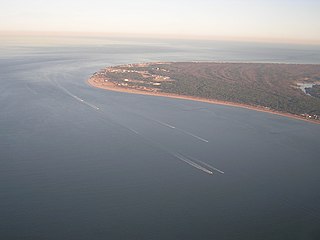
Cape Henry is a cape on the Atlantic shore of Virginia located in the northeast corner of Virginia Beach. It is the southern boundary of the entrance to the long estuary of the Chesapeake Bay.
Shortly after loading a cargo of hay, food, and gasoline, Berwyn left Baltimore for Hampton Roads, Virginia. She set out on her second voyage to France on 12 January 1919 and reached Quiberon Bay on the morning of 25 January 1919. On 27 January 1919, she received orders to proceed to Nantes because unloading facilities at St. Nazaire were filled to capacity. She reached Nantes late on 30 January 1919 and finally began unloading cargo early on 1 February 1919.

Hay is grass, legumes, or other herbaceous plants that have been cut and dried to be stored for use as animal fodder, particularly for large grazing animals raised as livestock, such as cattle, horses, goats, and sheep. However, it is also fed to smaller domesticated animals such as rabbits and guinea pigs. Even pigs may be fed hay, but they do not digest it as efficiently as herbivores.

Gasoline, petrol or gas is a colorless petroleum-derived flammable liquid that is used primarily as a fuel in spark-ignited internal combustion engines. It consists mostly of organic compounds obtained by the fractional distillation of petroleum, enhanced with a variety of additives. On average, a 42-U.S.-gallon (160-liter) barrel of crude oil yields about 19 U.S. gallons of gasoline after processing in an oil refinery, though this varies based on the crude oil assay.

Hampton Roads is the name of both a body of water that serves as a wide channel for the James, Nansemond and Elizabeth rivers between Old Point Comfort and Sewell's Point where the Chesapeake Bay flows into the Atlantic Ocean and the surrounding metropolitan region located in the Southeastern Virginia and Northeastern North Carolina portions of the Tidewater region.
Taking on board a return cargo of 1,224 tons of ammunition and 230 tons of steel rails, Berwyn departed Nantes on 14 February 1919. On 25 February 1919, while still on her voyage to the United States, she was transferred from the U.S. Army account to the U.S. Shipping Board account. Reaching Baltimore on 1 March 1919, she unloaded her cargo there before heading for Savannah, Georgia, on 8 March 1919. She stopped at Savannah from 11 to 15 March 1919, during which time she took on board 3,129 tons of cotton, and then got underway for Liverpool, England, on 16 March 1919.
After unloading her cargo alongside King's Dock at Liverpool between 2 and 17 April 1919, Berwyn departed Liverpool in ballast on 17 April 1919. Shortly before making landfall on the United States East Coast, she received orders to put into New York City, and reached Pier 94, North River, dropping anchor at the foot of 57th Street in Manhattan at 11:30 hours on 2 May 1919. Underway on 3 May 1919, she shifted to Pier 45, Brooklyn, New York.
Decommissioning and later career
Berwyn was decommissioned at Pier 45, Brooklyn, on 10 May 1919. She was transferred to the U.S. Shipping Board and stricken from the Navy List the same day. Third Officer A. W. Johnson of the U.S. Shipping Board assumed command on the ship - once again SS Berwyn – that day, and she soon began commercial operations under the Shipping Board.
During the summer of 1919, SS Berwyn carried general cargo to Liverpool, arriving there on 16 June 1919, before returning to Hampton Roads on 19 August 1919. She then proceeded to Galveston, Texas, where she loaded another general cargo between 29 August and 7 September 1919. Berwyn returned to European waters that autumn, reaching Liverpool on 6 October 1919. She then steamed to Norfolk, Virginia, before returning to Galveston on 3 December 1919. On 18 December 1919 she departed Galveston bound for Norfolk, then got underway from Norfolk for France, reaching Le Havre on 7 February 1920. She was reported as still in port there on 7 March 1920.
The French American Line, Inc., purchased Berwyn later in 1920. She was wrecked on 6 September 1920 on the Khuriya Muriya Islands in the Arabian Sea at approximately 17°44′N056°38′E / 17.733°N 56.633°E / 17.733; 56.633 (SS Berwyn) .





















